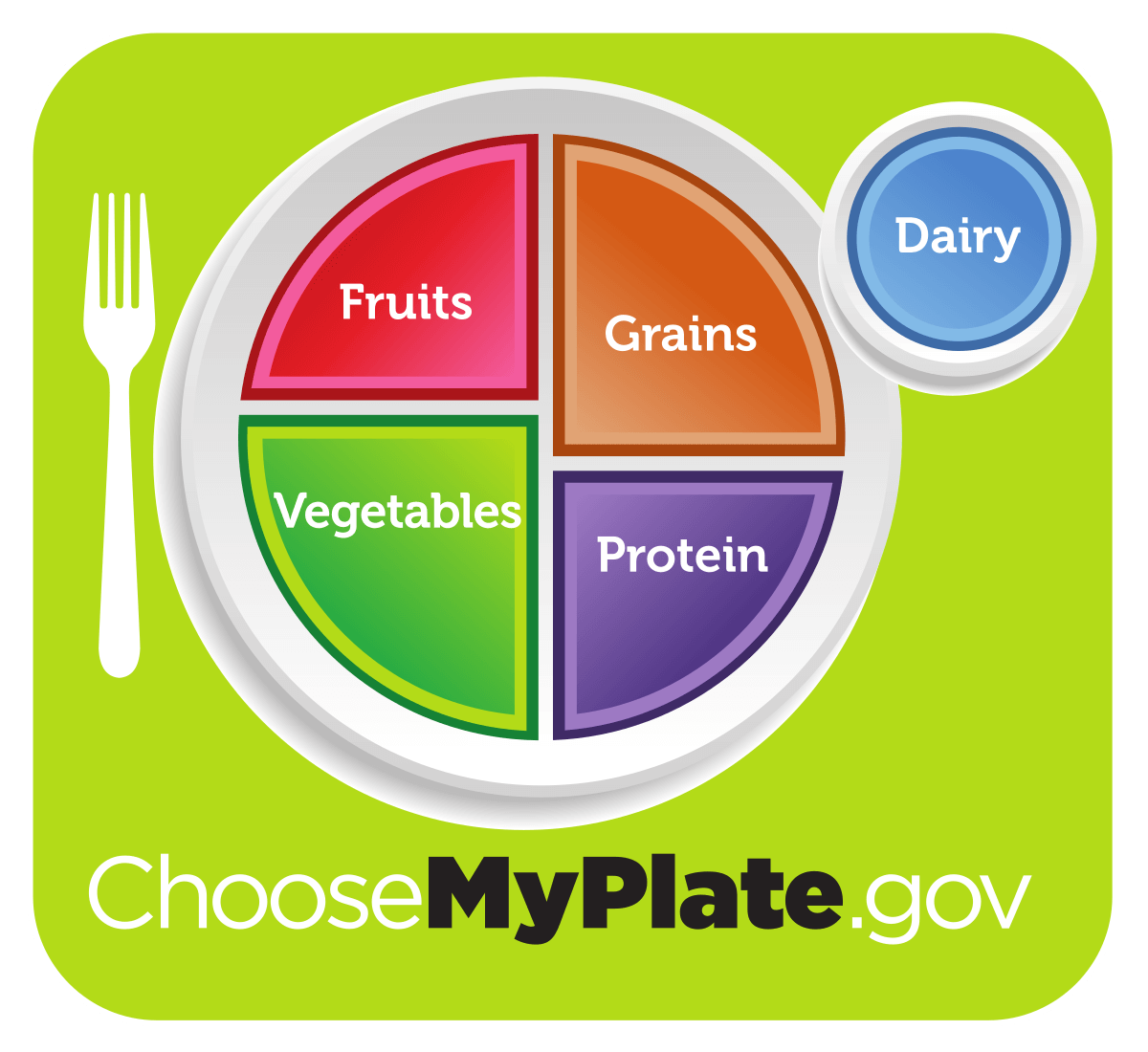MyPlate: The New and Improved Food Pyramid For Kids

Looking for a simple way to teach your children about nutrition? Do you remember learning about the Food Pyramid for kids? That’s been updated to MyPlate since then. This new version is more understandable and will actually make sense to your children! Now, nutrition is clear and plain.
As a parent, you want the best for your child. Building an ideal plate for both you and them will instill healthy eating habits and teach your child from a young age what their plate should look like. Growing up, you may have followed the food pyramid for kids. However, this food guide pyramid has been replaced by MyPlate.
What is MyPlate?
MyPlate is the new Food Pyramid for kids. In 2011, Michelle Obama took the lead in changing the confusing Food Pyramid to a more simplified model of the five food groups. Instead of a triangle, the image exemplifies what an actual plate a person should design around.
MyPlate is a guide that shapes what you would see when looking down at your table. Kids should eat a variety of different colored portions and a glass of milk on their weight. This model is more relatable and transferable for the public to replicate to their tables.

The Portions
People can easily see that it is ideal for them to fill half of your plate with fruits and vegetables with a quarter of grains, a quarter of protein, and a glass of dairy on the side. The representation is broad but still easily customizable.
Food Pyramid vs. MyPlate
The Food Pyramid for kids began at the base with a large group consisting of bread, cereal, brown rice, and pasta with the recommendation of 6 to 11 servings. In MyPlate, this section is condensed simply into the grains portion on 1/4th of the plate.
Resting on top were the vegetable (3-5 servings) and fruit groups (2-4 servings). MyPlate allows a more fluid choice of fruit and veggies servings.
Further up is the “milk, yogurt, cheese” group and the “meat, poultry, fish, eggs, cooked dry beans, and nuts” group. You can find these in the protein and glass of dairy in MyPlate. Protein is a more open category that allows for alternate protein sources such as tofu, tempeh, and alternatives to lean meats.

The tip of the pyramid is made of fats, oils, and sweets. As you can see on MyPlate, there is no category for these types of healthy diet inclusions because the goal of MyPlate was to aid in the obesity epidemic in America.
These foods are calorically dense, with 9 kilocalories per gram, making them more than double the calories in the same weight of protein and carbohydrates. Omitting them exemplifies that there is not always a place on a typical plate for each meal.
MyPlate For Kids
As a parent, you want the best for your child. Building an ideal plate for both you and them will instill healthy eating habits and teach your child from a young age what their plate should look like. Growing up, you may have followed the food pyramid for kids. However, this food guide pyramid has been replaced by MyPlate.
MyPlate is a great tool that you can introduce to children. The United States Department of Agriculture (USDA) has developed excellent resources as a way for kids to interact and learn about healthy eating tips and kids’ food choices. You can find different printables on their official website, MyPlate.gov.
Make mealtime exciting by using the veggie dice to decide what will be on their plates. You can even play grocery store bingo, color and design your plate, and create a whole lesson on whole grains.
Digging Deeper
The connotation of thoughts surrounding the ranking in a pyramid no longer exists in MyPlate. Grains are no longer the basis of a meal. This change is a positive one as in recent years, some have believed mainly carbs to be the main contributor to weight gain.
A more simplified guide creates a clear concept as to what a plate should be. The trouble is that it now no longer provides recommended servings of each component.
The Food Pyramid for kids provided the recommended serving sizes of each food component that kids should consume daily. Now, this is nonexistent.
Viewers must get this information from alternate child nutrition education sources. Overall, the MyPlate model shows what a single meal should exemplify, while the Food Pyramid provides information about what a full day may consist of.
Another controversy is the glass of dairy. Although many people believe dairy milk is the ideal calcium and vitamin D source, it isn’t the only one. Some sources assume that the dairy industry had a hand in making sure dairy stayed on the model. Canada has a highly similar food guide, except a glass of water replacing America’s glass of dairy.
Making Meals with MyPlate
For breakfast, consider an omelet with eggs and raw leafy greens, a cup of low-fat milk, a dried fruit cup, and a slice of toast. This meal encompasses all components without it looking directly like the model.
Lunch could be a bean and veggie wrap with a fruit smoothie. This meal won’t physically look like the MyPlate image, but kids are still consuming all components.
While prepping dinner, snack on fruit while teaching your children proper kitchen techniques, and talk about each other’s day. You can make dinner by getting a simple sheet pan meal with skinless chicken breast, sliced potatoes, and broccoli florets, then serving with a glass of milk or fruit juice.
MyPlate Key Takeaways
The food pyramid for kids is retired and replaced by a more simplified version. In MyPlate, fruits and veggies are more emphasized. Some resources go along with MyPlate to cultivate a healthy food relationship for you and your children.
Remember to always See a registered dietitian nutritionist for specific information and dietary guidelines. Meals can fit the MyPlate template without directly looking like it.
Final Thoughts
The update to MyPlate is one that was needed in order to keep up with new nutrition information and trends. This tool is now simplified and easily replicable by the general population. Showing what your everyday plate should actually consist of makes creating your own and teaching children what an adequate meal is.






